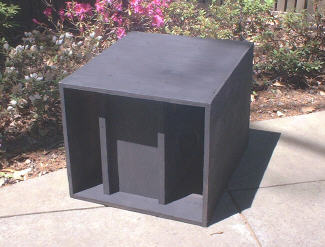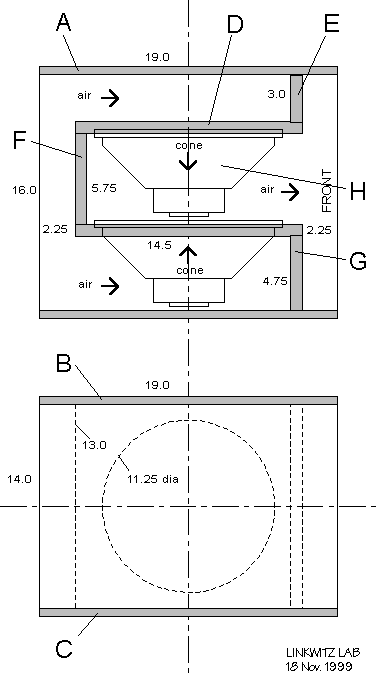|

| Build-Your-Own | Main Panel
| Dipole Woofer |
Dipole Woofer 2 | Dipole
Woofer 3 | Crossover/EQ
| Supplies |
| System Test | Design Models
| Prototypes | Active Filters
| Surround | FAQ |

All dimensions are in inch units unless otherwise stated.
(1" = 25.4 mm)
For construction use 0.75" and 0.5" thick Baltic plywood for
structural solidity.

A - Side panel (2x), 19" x 13" x 0.5"
An acoustically transparent, opaque cloth might be wrapped around the cabinet
sides.
B - Top, 19" x 16" x 0.5"
The panel might be finished around its edges and top surface for cosmetics.
C - Bottom, 19" x 16" x 0.5", with screw
holes if made removable.
The visible edges of the panel might be finished.
D - Baffle (2x), 14.5" x 13" x 0.75", one
11.25" diameter hole with 12.5" diameter recess of 0.25" depth, 8
screw holes.
E - Spacer, 13" x 3" x 0.75".
All spacers to be glued and screwed to the mating surfaces.
F - Spacer, 13" x 5.75" x 0.75"
G - Spacer, 13" x 4.75" x 0.75"
H - 12" Driver, Madisound
1252 DVC - 12" Dual Voice Coil Woofer.
April 2002 note:
The 1252DVC and X6100 drivers are no longer available. Select either Woofer2 or
Woofer3 as alternatives. They require a cabinet width of more than 16 inch,
because of larger magnet structures.
The driver is mounted to its baffle with metal screws and self locking nuts.
This is a tedious operation when the cabinet is completely assembled. Consider
to leave the cabinet bottom C removable or to have the drivers attached to their
baffles when assembling the cabinet. Use compressed weather stripping foam tape
between metal basket and wood.
Some drivers may buzz due to marginal attachment of the magnet assembly to the
basket. This is difficult to determine before the dipole woofer is completed. To
avoid this, apply a heavy bead of Silicone II Sealer & Glue to the gap
between magnet and basket.
A drop-in replacement woofer of higher quality construction
and without the potential buzz problem is the Gefco X6100 single voice coil
woofer. It is built with a stronger basket and a non-foam surround. The driver
is no longer available from Madisound.
Before selecting different drivers see FAQ4
and Woofer2. I have since
found a real alternative if you want to built a stacked woofer for larger
output, which would normally take four 1252DVC, see Woofer3.
The 16" cabinet width is the result of the driver
dimensions and an effort to minimize the overall size of the dipole woofer. I
consider the slight assembly difficulties a worthwhile trade-off. There is an
added benefit to the chosen driver arrangement. The direction of cone movement
is such that mechanical forces cancel and only a minimum of vibration is
transferred to the cabinet's outside surfaces for possible re-radiation. Force
cancellation is important because of the large cone excursions necessary for
dipole operation and the associated large reaction forces. - Ref.4,
theory.gif, spl_max1.xls
The two drivers are wired
in parallel. On each 1252DVC connect the two voice coil windings in series
(red to black), then wire the two drivers in parallel, accounting for their
push-pull operation (red to black, black to red). Check with a D-Cell, 1.5 V
battery, that both cones move towards each other when seen from the front of the
cabinet, when the positive terminal of the battery is connected to the positive
terminal of your wiring. One cone moves out of the magnet, while the other cone
moves into it.
The woofer is directional with a cos(angle) or
figure-of-eight polar pattern. The response is 3 dB down at 450
off-axis. When placed near the side walls the woofer may need to be angled
towards the listening position.
The woofer requires electronic equalization of the 6
dB/oct frequency response roll-off which is due to front-to-rear sound
cancellation. | Crossover/EQ
|
You will find measured frequency response data on the | System
Test | page
and answers to a number of woofer related questions on the | FAQ
| page. Acoustic theory of open-baffle woofers is on the | Design
Models | page.

| Build-Your-Own | Main Panel
| Dipole Woofer | Crossover/EQ
| Supplies |
| System Test | Design Models
| Prototypes | Active Filters
| Surround | FAQ |
|